
Concept explainers
(a)
To find: The complete graph of the function when the function is odd.
(a)
Answer to Problem 112E
The complete graph of the function is shown in Figure(1).
Explanation of Solution
Given information:
The function is odd and half graph of the function is given below:
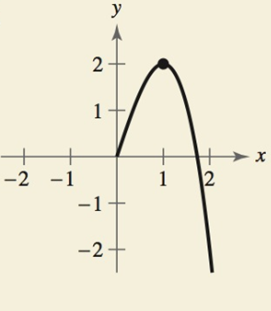
Calculation:
As the given function is odd, so the graph of the odd function is always symmetric about origin.
So, take the symmetric graph about the origin and complete the graph.
The complete graph taken by reflection in origin is given below:
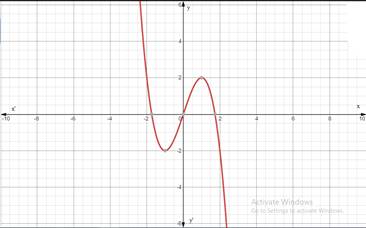
Figure(1)
(b)
To find: The domain and range of the function.
(b)
Answer to Problem 112E
The domain and range of the function are both equal to
Explanation of Solution
Given information:
The function is odd and half graph of the function is given below:
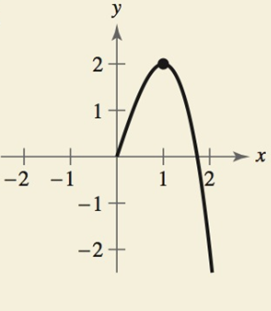
Calculation:
As observed from the graph in part(a), the function is defined for all the real values of
So, the domain of the function is equal to
As observed from the graph in part(a), the values of
So, the range of the function is also equal to
Therefore, the domain and range of the function are both equal to
(c)
To find: The intervals on which the function is increasing, decreasing or constant.
(c)
Answer to Problem 112E
The function is increasing on the interval
Explanation of Solution
Given information:
The function is odd and half graph of the function is given below:
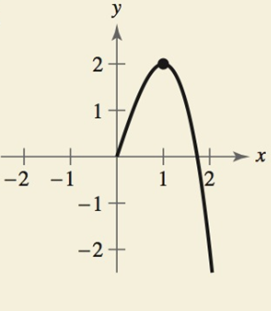
Calculation:
As observed from the graph in part(a), the function is increasing from
As observed from the graph in part(a), the function is decreasing from
Therefore, the function is increasing on the interval
(d)
To find: The
(d)
Answer to Problem 112E
The relative maximum value of the function is
Explanation of Solution
Given information:
The function is odd and half graph of the function is given below:
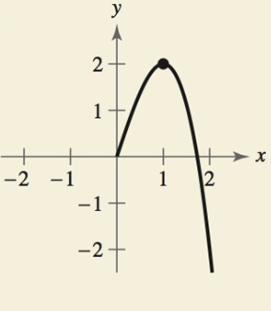
Calculation:
As observed from the graph in part(a), the function achieves a relative maximum value at
So, the relative maximum value of the function is equal to
As observed from the graph in part(a), the function achieves a relative minimum value at
So, the relative minimum value of the function is equal to
Therefore, the relative maximum value of the function is
Chapter 1 Solutions
EP PRECALC.GRAPHING APPR.-WEBASSIGN-1YR
- Find the accumulated amount A, if the principal P is invested at an interest rate of r per year for t years. (Round your answer to the nearest cent.) P = $3800, r = 4%, t = 10, compounded semiannually A = $ 5645.60 × Need Help? Read It SUBMIT ANSWER [3.33/6.66 Points] DETAILS MY NOTES REVIOUS ANSWERS ASK YOUR TEACHER TANAPCALC10 5.3.001.EP. PRACTICE ANOTHER Consider the following where the principal P is invested at an interest rate of r per year for t years. P = $3,100, r = 4%, t = 10, compounded semiannually Determine m, the number of conversion periods per year. 2 Find the accumulated amount A (in dollars). (Round your answer to the nearest cent.) A = $ 4604.44arrow_forwardForce with 800 N and 400 N are acting on a machine part at 30° and 60°, respectively with a positive x axis, Draw the diagram representing this situationarrow_forwardI forgot to mention to you to solve question 1 and 2. Can you solve it using all data that given in the pict i given and can you teach me about that.arrow_forward
 Calculus: Early TranscendentalsCalculusISBN:9781285741550Author:James StewartPublisher:Cengage Learning
Calculus: Early TranscendentalsCalculusISBN:9781285741550Author:James StewartPublisher:Cengage Learning Thomas' Calculus (14th Edition)CalculusISBN:9780134438986Author:Joel R. Hass, Christopher E. Heil, Maurice D. WeirPublisher:PEARSON
Thomas' Calculus (14th Edition)CalculusISBN:9780134438986Author:Joel R. Hass, Christopher E. Heil, Maurice D. WeirPublisher:PEARSON Calculus: Early Transcendentals (3rd Edition)CalculusISBN:9780134763644Author:William L. Briggs, Lyle Cochran, Bernard Gillett, Eric SchulzPublisher:PEARSON
Calculus: Early Transcendentals (3rd Edition)CalculusISBN:9780134763644Author:William L. Briggs, Lyle Cochran, Bernard Gillett, Eric SchulzPublisher:PEARSON Calculus: Early TranscendentalsCalculusISBN:9781319050740Author:Jon Rogawski, Colin Adams, Robert FranzosaPublisher:W. H. Freeman
Calculus: Early TranscendentalsCalculusISBN:9781319050740Author:Jon Rogawski, Colin Adams, Robert FranzosaPublisher:W. H. Freeman
 Calculus: Early Transcendental FunctionsCalculusISBN:9781337552516Author:Ron Larson, Bruce H. EdwardsPublisher:Cengage Learning
Calculus: Early Transcendental FunctionsCalculusISBN:9781337552516Author:Ron Larson, Bruce H. EdwardsPublisher:Cengage Learning





